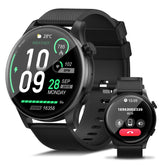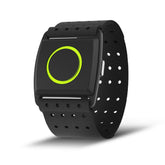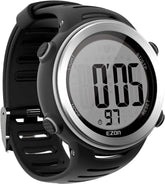Triathlon Success Unlocked: Sports Wearables for Training Intensity Optimization
Triathlon—swim, bike, run—is a test of balanced strength, where success hinges on nailing intensity across three distinct disciplines. Too hard in the swim, and you’ll bonk on the bike; too easy on the bike, and you’ll waste energy for the run. Sports wearable technology solves this balancing act, turning fragmented data into a unified intensity strategy. EZON’s GPS Series, Heart Rate Series, and Sports Watch Series act as your multi-sport coach, fine-tuning effort in every segment to unlock peak performance.
Why Training Intensity Matters in Triathlon
Triathlon’s unique challenge is that each discipline taxes your body differently:
- Swim: Demands steady aerobic effort (60–75% MHR) to conserve energy for later legs.
- Bike: Requires sustained sub-threshold effort (70–85% MHR) to build speed without draining glycogen.
- Run: Relies on controlled intensity (75–80% MHR) to finish strong after two prior disciplines.
Generic training plans miss the mark—your body’s response to intensity varies daily. A sports wearable like the EZON R7 (from GPS Series) adapts in real time, ensuring you hit the sweet spot for each sport, every session.
Swim: Optimizing Intensity with Water-Proof Tech
The swim sets the tone, and intensity here is all about efficiency:
-
Key Metrics to Track:
- Heart Rate Zones: Stay in 60–70% MHR (Zone 2) for long swims to build aerobic endurance. The C009Pro chest strap (Heart Rate Series) transmits underwater, alerting you if you spike into Zone 3 (wasting energy).
- SWOLF Score: Combines time and stroke count (lower = more efficient). R7 calculates this, so you know: “A SWOLF of 45 for 50m means my intensity is right—strokes are powerful, not wasteful.”
- Pace Consistency: Use R7’s GPS (for open water) or motion sensors (for pools) to ensure lap times vary by <5 seconds. Erratic pace signals uneven intensity.
-
Pro Tip: Do 8x 100m repeats, keeping heart rate <70% MHR. R7 logs each repeat’s SWOLF—aim for consistency. A sudden jump means you’re overexerting.
Bike: Balancing Power and Endurance
The bike is where intensity builds momentum—wearables prevent burnout:
-
Key Metrics to Track:
- Heart Rate + Cadence Sync: Aim for 70–80% MHR with 80–90 RPM cadence. R7’s bike mode pairs these, vibrating if cadence drops (signaling too much gear, increasing strain) or heart rate spikes (signaling unsustainable effort).
- Power Correlation: For advanced athletes, sync R7 with a power meter—target 70–80% FTP (functional threshold power) for long rides. The watch flags when power outpaces heart rate (a sign of fatigue).
- Elevation Adjustment: R7’s GPS maps hills, auto-adjusting intensity targets: “Climb ahead—shift to 75–85% MHR; descend—drop to 65–70% MHR to recover.”
-
Pro Tip: 3x 20-minute bike intervals at 75% MHR, with 5-minute Zone 1 rests. Use C009Pro to ensure recovery heart rate drops to <60% MHR—this builds the endurance to hold pace through the bike’s final miles.
Run: Finishing Strong with Controlled Effort
The run is where intensity must align with residual energy—wearables prevent the “wall”:
-
Key Metrics to Track:
- Heart Rate Recovery Post-Bike: After transitioning from bike to run, R7 checks if your heart rate drops 10 BPM in 2 minutes. If not, ease to 70% MHR for 5 minutes—you’re still carrying bike fatigue.
- Pace-to-Heart Rate Ratio: A 155-lb runner should maintain 8:00/mile at 75% MHR. R7 flags if pace slows while heart rate rises (signaling glycogen depletion—time to fuel).
- Stride Cadence: Keep 160–180 steps/min to avoid overstriding (which increases fatigue). R7’s accelerometer vibrates if cadence dips, prompting shorter, quicker steps.
-
Pro Tip: Practice “brick runs” (bike + immediate run) with R7. Log how heart rate at 1 mile compares to a standalone run—over time, the gap should shrink (a sign of better transition fitness).
12-Week Triathlon Training Plan: Intensity Progression with Wearables
| Week | Focus | Swim (45min) | Bike (60min) | Run (30min) | Wearable Feature to Use |
|---|---|---|---|---|---|
| 1–4 | Base Intensity | Zone 2 swims (C009Pro) | Steady Zone 2 rides (R7) | Easy Zone 2 runs (C022Pro) | R7’s multi-sport mode to log total load |
| 5–8 | Build Threshold | 10min Zone 3 sprints | 15min Zone 3 intervals | 8min Zone 3 repeats | C009Pro alerts to hit 75–80% MHR |
| 9–12 | Race Simulation | Full swim (SWOLF tracking) | Full bike (power sync) | Full run (pace alerts) | R7’s transition timer to mimic race intensity shifts |
EZON Wearables: The Intensity Optimization Toolkit
R7 (GPS Series): The Triathlete’s Command Center
-
Key Features:
- 5ATM waterproofing + 20-hour GPS battery (lasts Olympic-distance races).
- Auto-sport detection (swim → bike → run) with seamless intensity tracking.
- “Triathlon mode” aggregates data to show overall training load (avoids overdoing any discipline).
C009Pro (Heart Rate Series): Precision Across All Sports
- Advantages: ±1 BPM accuracy in water, on bike, or running—critical for consistent intensity data. 365-hour battery means no mid-week charging.
C022Pro (Heart Rate Series): Run-Specific Comfort
- Benefits: Armband design avoids chafing during long runs, with 5 heart rate zones to guide post-bike effort.
FAQs: Training Intensity with Triathlon Wearables
Q: How do I know if my overall training intensity is balanced?
- R7’s “load score” (1–100) combines swim, bike, and run data. Aim for 70–80—below 60 means under-training; above 90 signals overreach.
Q: Can I use a single wearable for all three sports?
- Yes—R7 (GPS Series) is engineered for swim, bike, and run, with sensors tailored to each. Pair with C009Pro for underwater heart rate accuracy.
Q: How to adjust intensity on tired days?
- Check R7’s resting heart rate (RHR). A 5+ BPM rise means scale back: swim at 55–60% MHR, bike at 65–70% MHR, run at 70–75% MHR.
Train Intelligently, Race Confidently
Triathlon success isn’t about maxing out in one discipline—it’s about optimizing intensity across all three. With sports wearable technology from EZON, you’ll train with purpose, turning data into the balanced strength that wins races.









